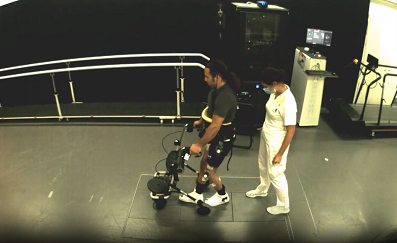The use of RYSEN and EES for complete spinal cord injury rehabilitation
Motek
Our partner Motek have shared how the RYSEN body weight support system was used in ground-breaking research and rehabilitation for complete paraplegic injury.
Read the full case report here.
Introduction
After a complete spinal cord injury (SCI), neurological assessments show no spared motor or sensory function below the level of injury. Decreased mobility after SCI is associated with a heightened risk of a decrease in both life satisfaction and quality of life. Epidural electrical stimulation (EES) is a treatment approach to reactivate the spinal cord below the injury. An implantable pulse generator delivers bursts of electrical stimulation at specific locations over the spinal cord and with a timing that coincides with the intended leg movements. This epidural electrical stimulation (EES) targeting the dorsal roots of lumbosacral segments reactivates the spinal cord below the injury and amplifies the residual commands from the brain. EES immediately restores stepping in people with severe spinal cord injury.
Case description
We present a case of an intensive rehabilitation combining EES and physical therapy in a complete traumatic spinal cord injury (AIS-B, T6-T10). A 29-year-old male patient was included in the clinical research study STIMO (STImulation Movement Overground) and EES was implanted in July 2020. Then, the patient was trained to stand and to walk with EES during five months, with 4 sessions/week. The sessions of physical therapy included trunk stability, leg reinforcement and functional movements. The bodyweight support (BWS) of the RYSEN was necessary during the early phase of the walking rehabilitation.
Results
At the end of the rehabilitation, the patient was able to stand 21 seconds without assistive device and to walk 56 meters with a walker without BWS while the stimulation is turned on.
The RYSEN was a significant help to ensure the safety of the walking rehabilitation. The adjustment of the bodyweight support allows the therapist to work efficiently with the progress of the patient. Furthermore, this case shows that EES and intensive physical therapy was effective to improve motor function and walking ability in a patient with thoracic spinal cord injury.
About the RYSEN
The RYSEN is the next generation of 3D body weight support.
Developed by Motek, the RYSEN supports patients in an all-directional, assist as-needed capacity to improve movement function. The RYSEN offers therapists and patients the opportunity to train movement, gait and balance in an unrestricted and safe environment, both for clinical and research purposes.
Its technology combines adjustable vertical body weight support with horizontal and vertical assistive forces, maximising a patient’s freedom of movement, engagement, and recovery results.
Click here to view the RYSEN product page.
About NeuroRestore
This case report was authored by Dr Jocelyne Bloch, Professor Dr Grégoire Courtine, Manon Tschopp, Aurélie Paley and Natacha Herrmann from NeuroRestore, Centre Hospitalier Universitaire Vaudois (CHUV), Lausanne Switzerland.
NeuroRestore is a research, innovation and treatment centre that develops and applies bioengineering strategies involving neurosurgical interventions to restore neurological functions.
Contact us
Get in touch with Summit Medical and Scientific today to find out more about incorporating state-of-the-art rehabilitation technology like the RYSEN into your clinical practice or upcoming research project. Contact us via email at info@summitmedsci.co.uk or call 01372 3459863.
You can also follow us on Facebook, Twitter and LinkedIn, and subscribe to our newsletter for the latest updates.
Want to view all of our clinical rehabilitation technology? View all our solutions here.

